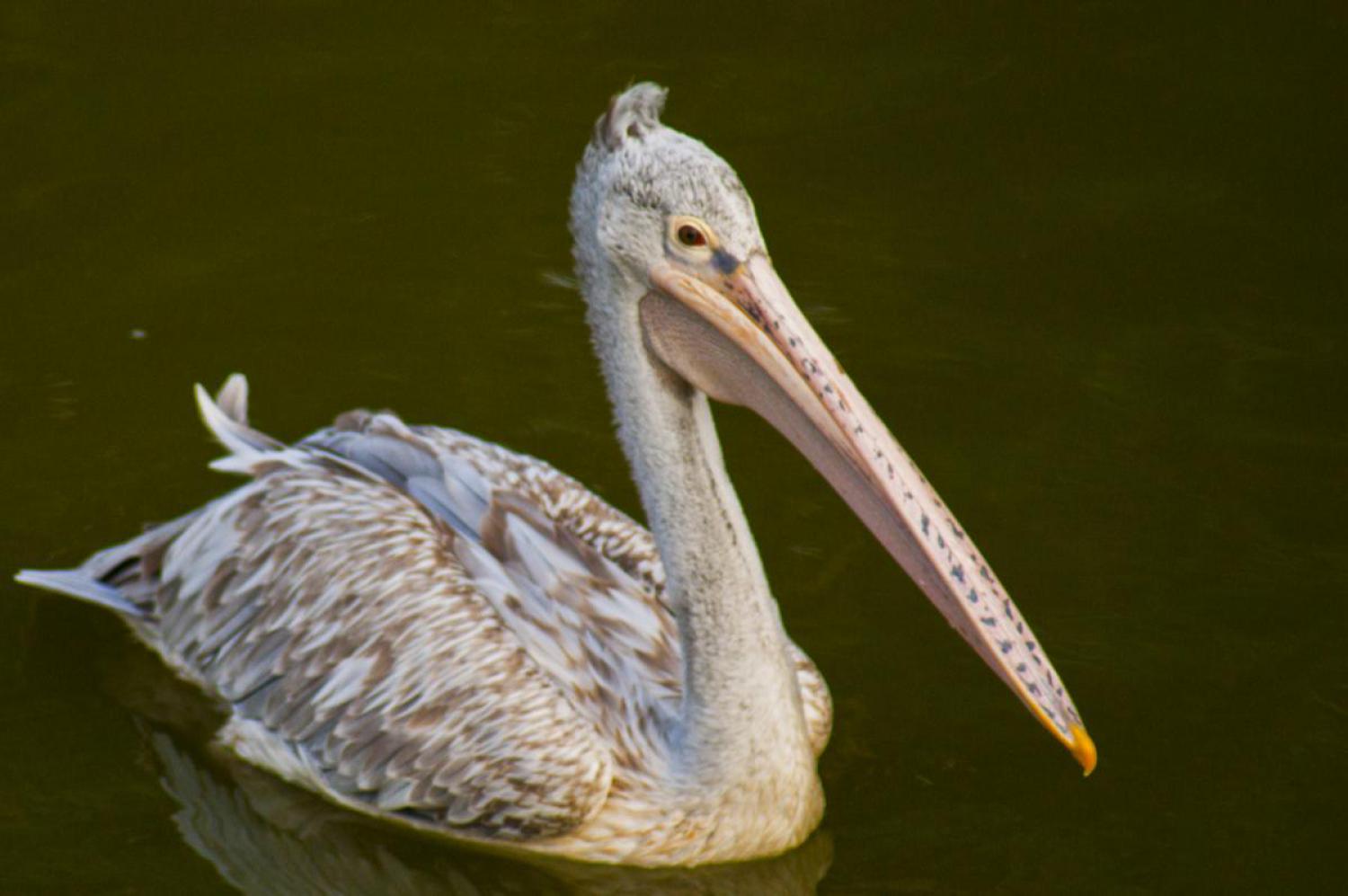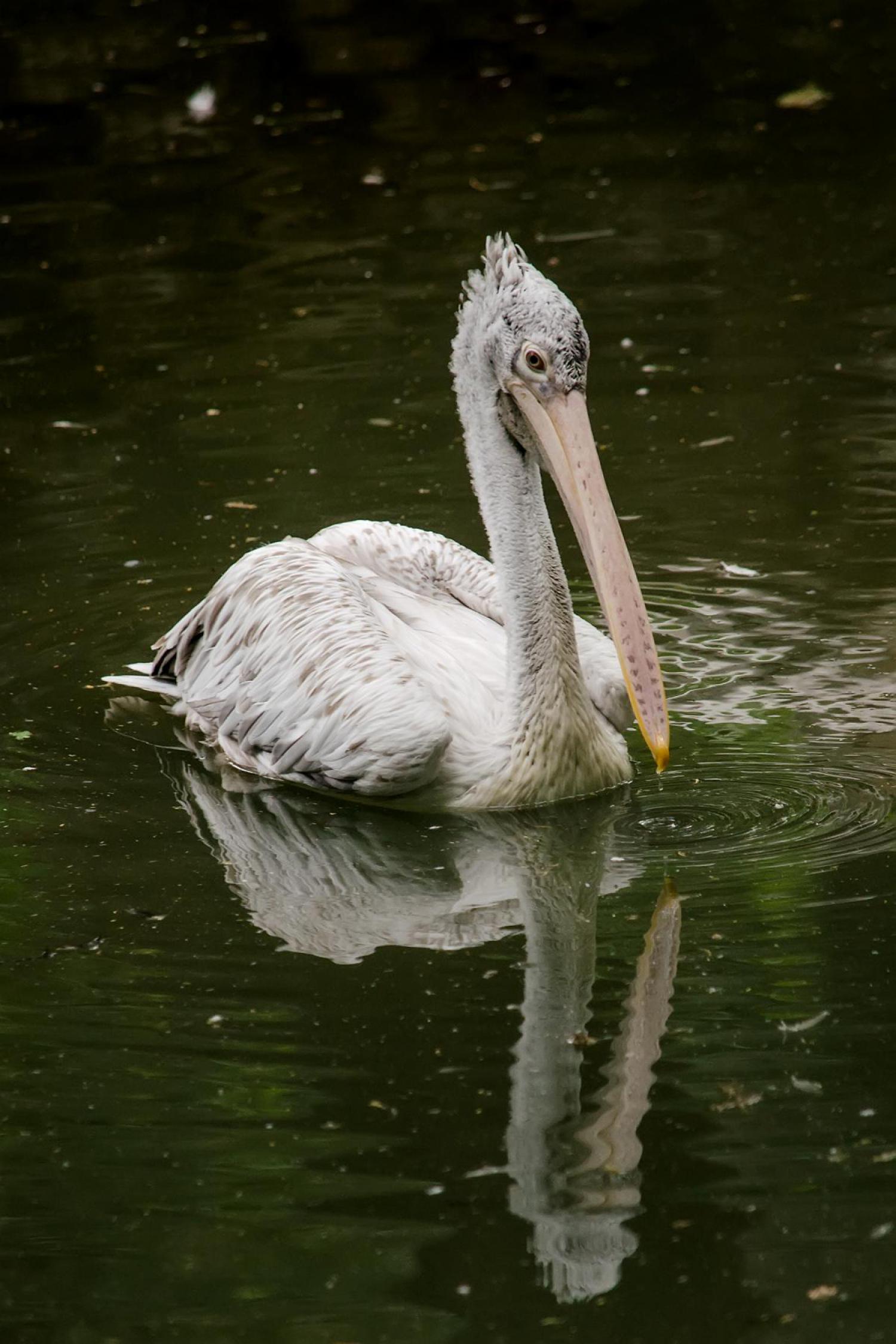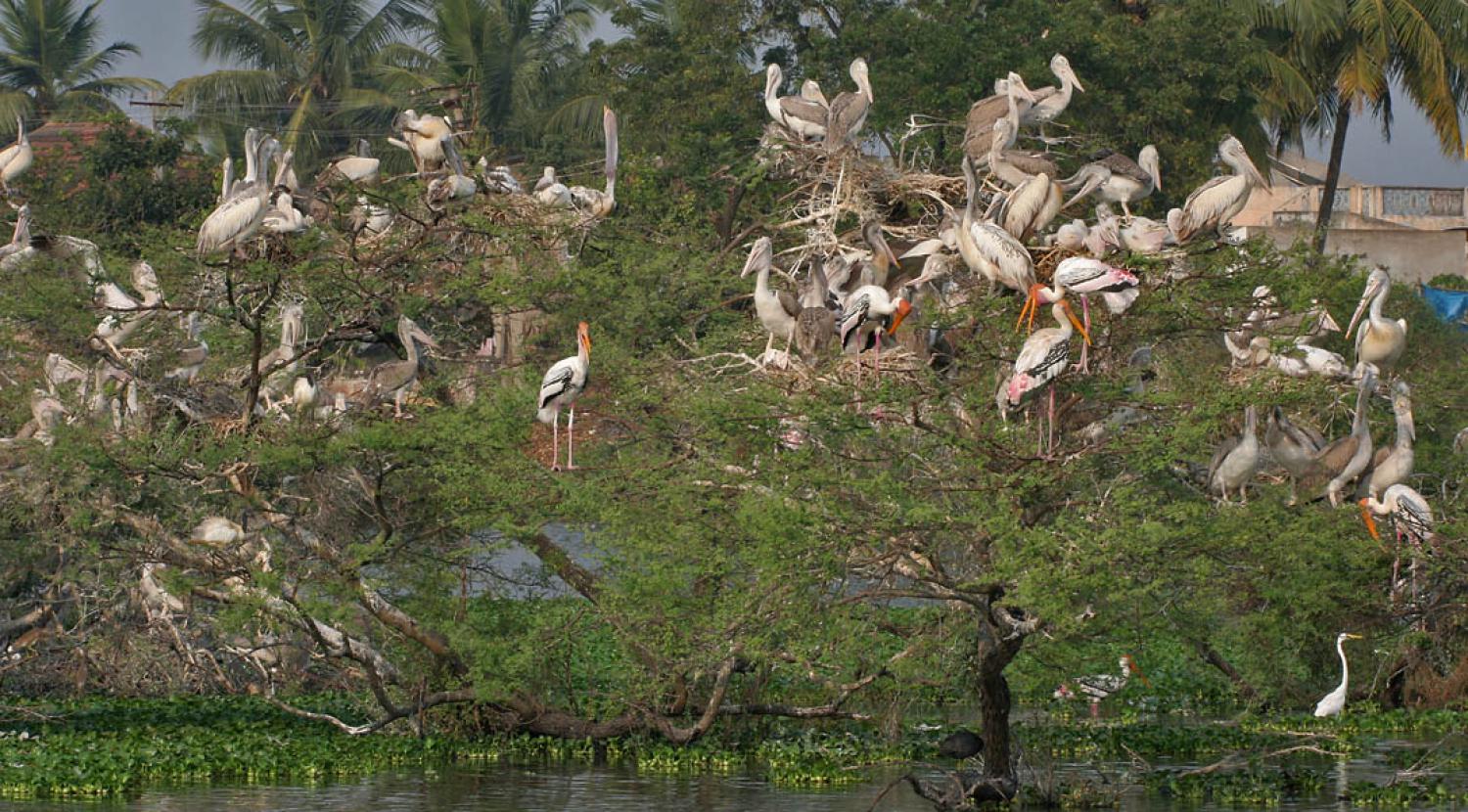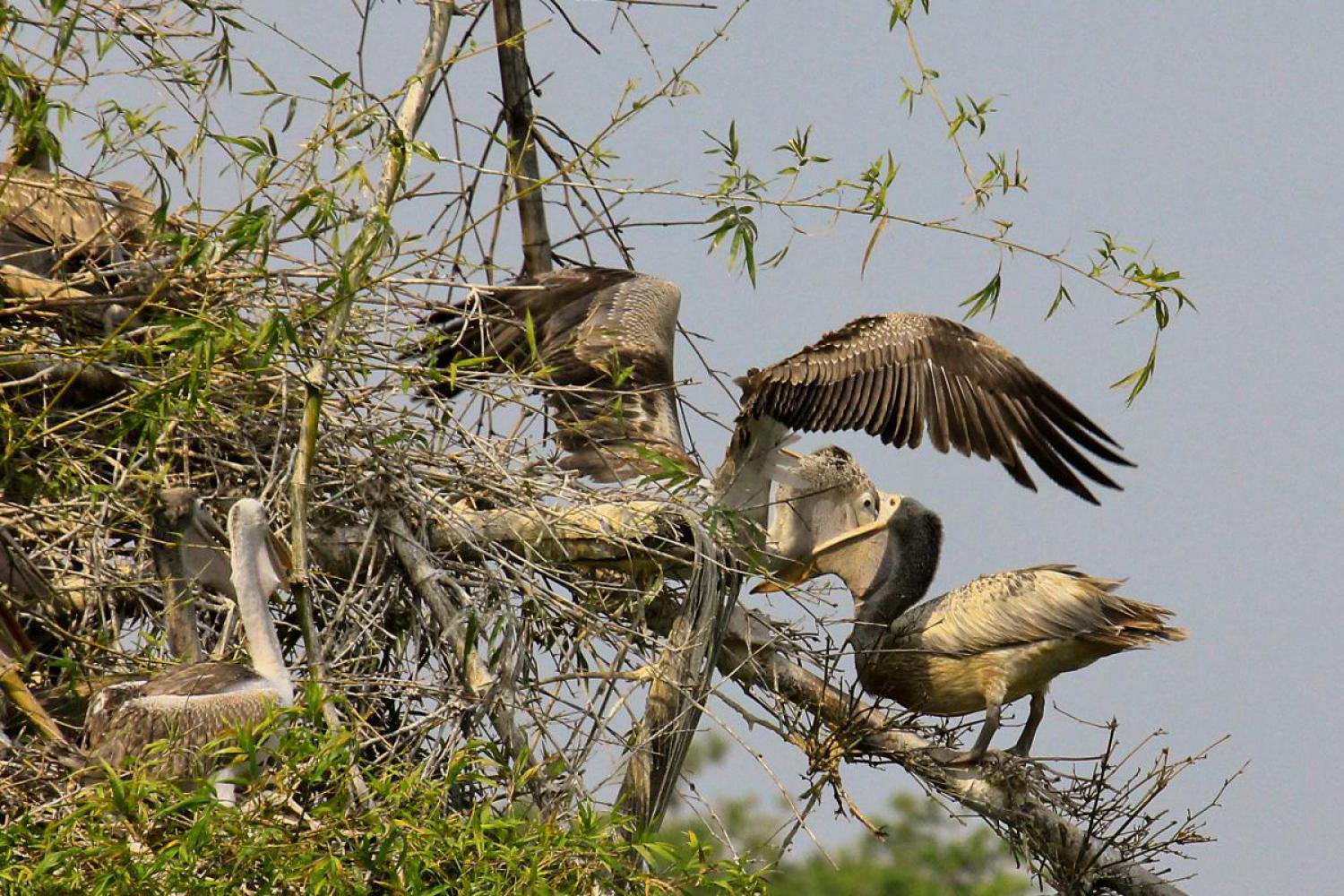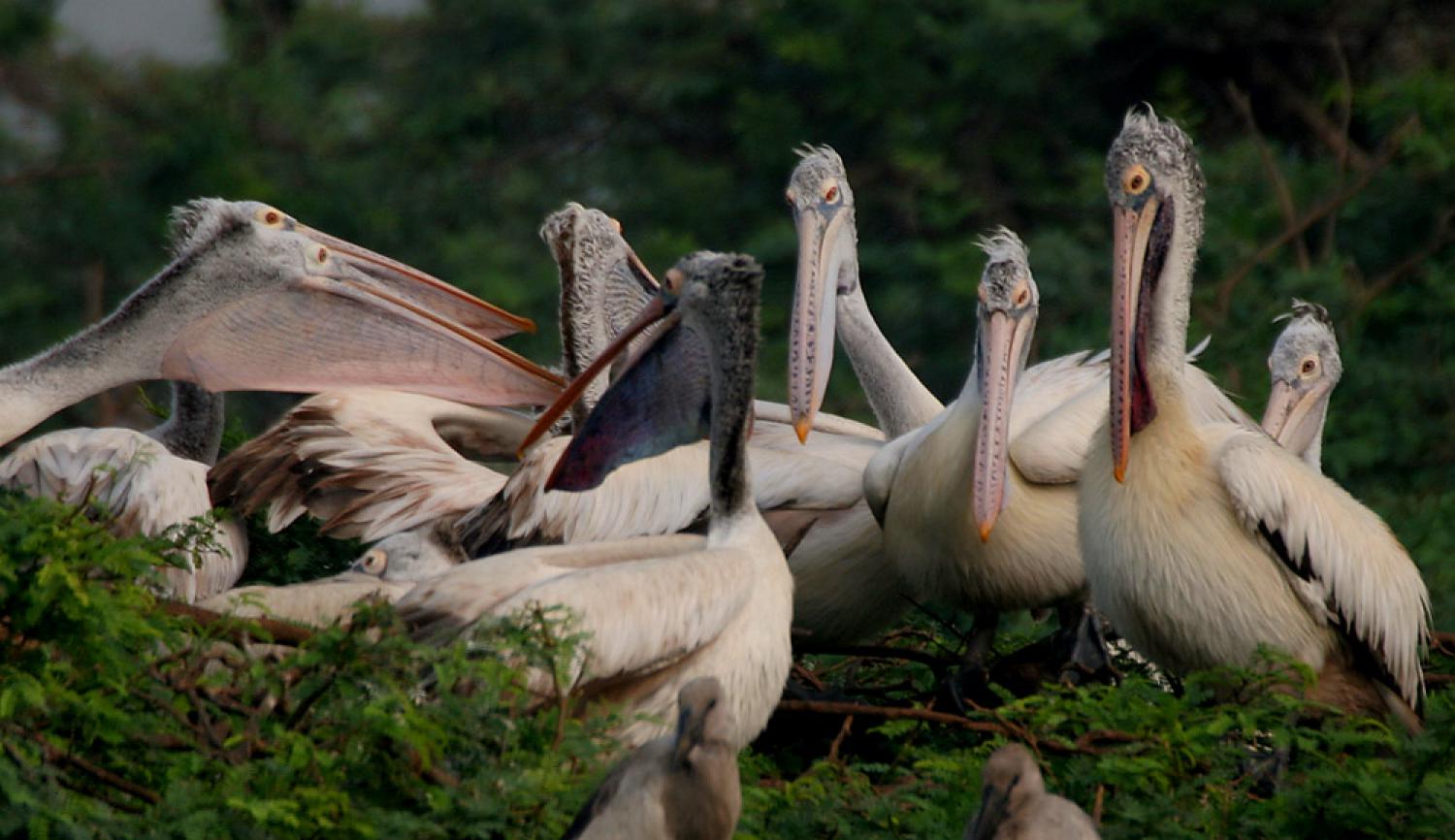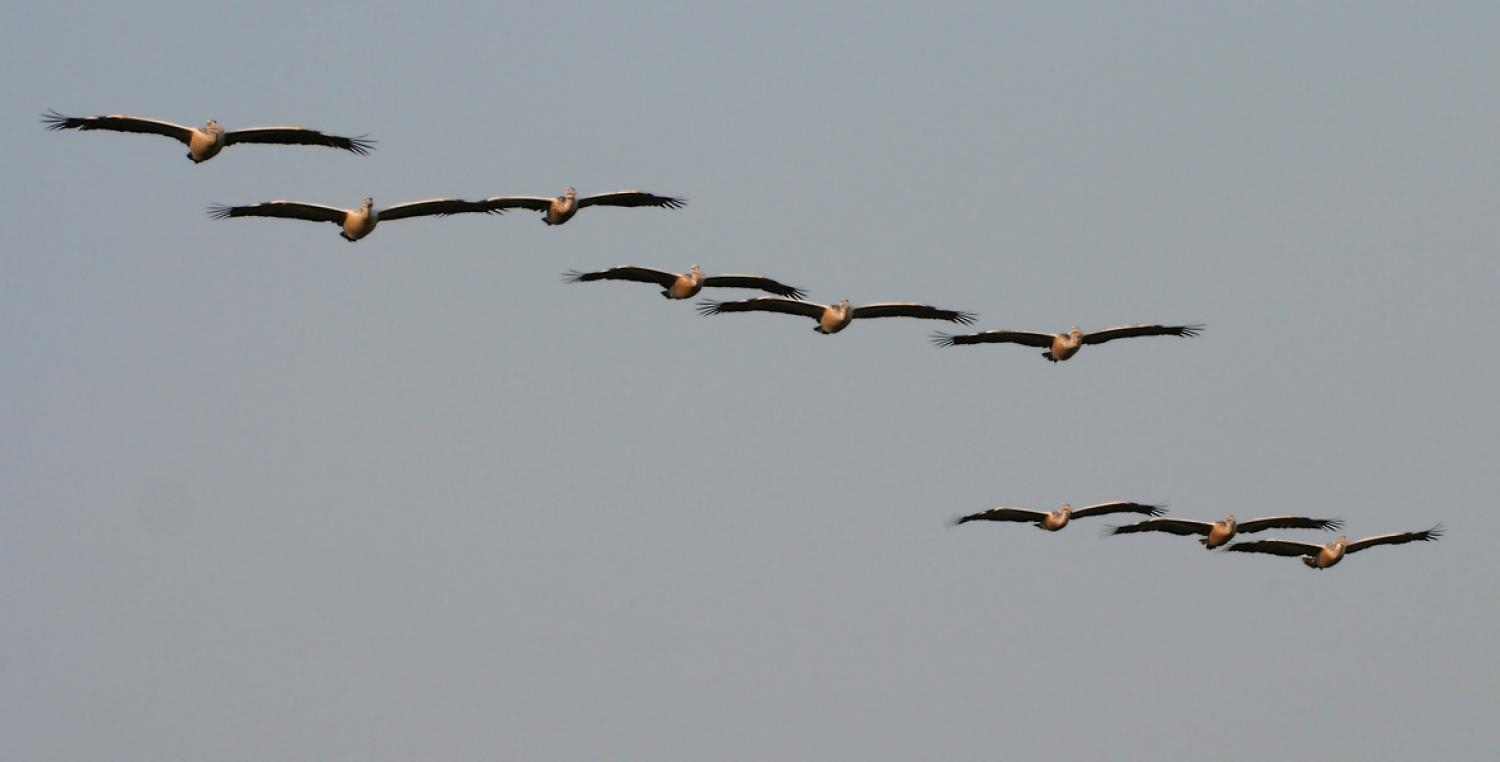Species of Thailand
Spot-billed pelican
Pelecanus philippensis
Johann Friedrich Gmelin, 1789
In Thai: นกกระทุง
The spot-billed pelican or grey pelican (Pelecanus philippensis) is a member of the pelican family. It breeds in southern Asia from southern Pakistan across India east to Indonesia. It is a bird of large inland and coastal waters, especially large lakes. At a distance they are difficult to differentiate from other pelicans in the region although it is smaller but at close range the spots on the upper mandible, the lack of bright colours and the greyer plumage are distinctive. In some areas these birds nest in large colonies close to human habitations.
Description
The spot-billed pelican is a relatively small pelican but still a large bird. It is 125–152 cm (49–60 in) long and a weight of 4.1–6 kg (9–13.2 lbs). It is mainly white, with a grey crest, hindneck and a brownish tail. The feathers on the hind neck are curly and form a greyish nape crest. The pouch is pink to purplish and has large pale spots, and is also spotted on the sides of the upper mandible. The tip of the bill (or nail) is yellow to orange. In breeding plumage, the skin at the base of the beak is dark and the orbital patch is pink. In flight they look not unlike the Dalmatian pelican but the tertials and inner secondaries are darker and a pale band runs along the greater coverts. The tail is rounder.
The newly hatched young are covered in white down. They then moult into a greyish speckled plumage. The spots on the bill appear only after a year. The full adult breeding plumage appears in their third year.
Habitat, distribution and status
The species is found to breed only in peninsular India, Sri Lanka and in Cambodia. A few birds from India are known to winter in the Gangetic plains but reports of its presence in many other parts of the region such as the Maldives, Pakistan and Bangladesh has been questioned. The main habitat is in shallow lowland freshwaters. The spot-billed pelican is not migratory but are known to make local movements and are more widely distributed in the non-breeding season.
This species is a colonial breeder, often breeding in the company of other waterbirds. The nests are on low trees near wetlands and sometimes near human habitations. Many large breeding colonies have been recorded and several have disappeared over time. In June 1906, C E Rhenius visited a colony in Kundakulam in Tirunelveli district where the villages considered the birds semi-sacred. The same colony was revisited in 1944, and was found to have about 10 nests of pelicans and nearly 200 nests of painted stork.
The Sittang River in Burma was said by E W Oates to have "millions" of pelicans in 1877 and in 1929 E C Stuart Baker reported that they were still nesting in thousands along with Greater Adjutant Storks:
This colony was however reported by B E Smythies to have disappeared between the 1930s and the 1940s.
Another colony was discovered in 1902 at a village called Buchupalle in the Cudappah district, where these pelicans nested along with painted storks during the month of March. This colony was never traced again. The Kolleru Lake colony was discovered by K K Neelakantan in 1946. Nearly 3000 pelicans nested in this colony at the time of discovery. This colony however disappeared around 1975.
Due to habitat loss and human disturbance, the spot-billed pelican's numbers have declined and many populations in Southeast Asia are now extinct. The specific name refers to the Philippines, where the species was abundant in the early 1900s but declined and become locally extinct in the 1960s. The populations in southern India are thought to be on the rise. Estimates suggest that increased protection has since enabled a recovery in their numbers and the status of the species was changed from Vulnerable to Near Threatened in the 2007 IUCN Red List.
Behaviour and ecology
They are very silent although at their nests they can make hisses, grunts or snap their bills. Some early descriptions of nesting colonies have claimed them to be distinctive in their silence but most have noted colonies as noisy.
Like most other pelicans, it catches fish in its huge bill pouch while swimming at the surface. Unlike the great white pelican it does not form large feeding flocks and is usually found to fish singly or in small flocks. Groups may however sometimes line up and drive fish towards the shallows. When flying to their roosts or feeding areas, small groups fly in formation with steady flapping. During the hot part of the day, they often soar on thermals. They may forage at night to some extent.
The birds nest in colonies and the nest is a thick platform of twigs placed on a low tree. The breeding season varies from October to May. In Tamil Nadu, the breeding season follows the onset of the Northeast Monsoon. The courtship display of the males involves a distention of the pouch with swinging motions of the head up and down followed by sideways swings followed by the head being held back over the back. Bill claps may also be produced during the head swaying movements. The nests are usually built alongside other colonial waterbirds, particularly painted storks. Three to four chalky white eggs is the usual clutch. The eggs become dirty with age. Eggs hatch in about 30–33 days. The young stay in or near the nest from three to five months. In captivity the young are able to breed after two years. Like other pelicans, they cool themselves using gular fluttering and panting.
In culture
This species was once used by fishermen in parts of eastern Bengal as decoys for certain fish. These fishermen believed that an oily secretion from the bird attracted certain fish such as Colisa and Anabas.
The propensity of these birds to nest close to human habitations has been noted from the time of T C Jerdon:
Several colonies have since been discovered and while many of these have vanished others have been protected and a few villages with nesting colonies have become popular tourist attractions. Well known villages with colonies include Kokrebellur, Koothankulam and Uppalapadu.
This article uses material from Wikipedia released under the Creative Commons Attribution-Share-Alike Licence 3.0. Eventual photos shown in this page may or may not be from Wikipedia, please see the license details for photos in photo by-lines.
Category / Seasonal Status
Wiki listed status (concerning Thai population): Rare, probably once bred
BCST Category: Recorded in an apparently wild state within the last 50 years
BCST Seasonal statuses:
- Resident or presumed resident
- Non-breeding visitor
Scientific classification
- Kingdom
- Animalia
- Phylum
- Chordata
- Class
- Aves
- Order
- Pelecaniformes
- Family
- Pelecanidae
- Genus
- Pelecanus
- Species
- Pelecanus philippensis
Common names
- Thai: นกกระทุง
Conservation status

Near Threatened (IUCN3.1)

Near Threatened (BirdLife)

Near Threatened (ONEP)

Near Threatened (BCST)
Photos
Please help us review the bird photos if wrong ones are used. We can be reached via our contact us page.
Range Map
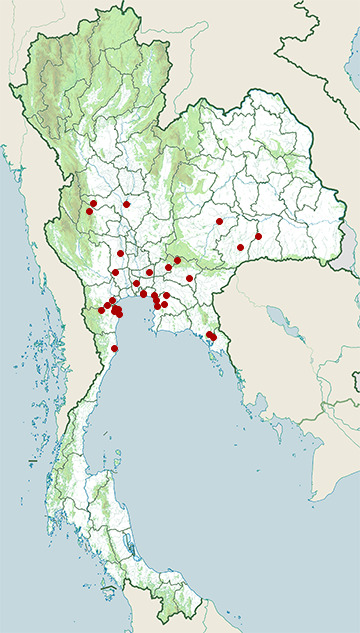
- Amphawa District, Samut Songkhram
- Ban Bueng District, Chonburi
- Ban Laem District, Phetchaburi
- Bang Pakong District, Chachoengsao
- Bang Phra Non-Hunting Area
- Bang Pu Recreation Centre
- Bangkok Province
- Bueng Boraped Non-Hunting Area
- Huai Kha Khaeng Wildlife Sanctuary
- Kabin Buri District, Prachinburi
- Kamphaeng Saen District, Nakhon Pathom
- Khao Sam Roi Yot National Park
- Khao Saming District, Trat
- Khao Yai National Park
- Khao Yoi District, Phetchaburi
- Khlung District, Chanthaburi
- Laem Pak Bia
- Mae Poen District, Nakhon Sawan
- Mueang Chonburi District, Chonburi
- Mueang Phetchaburi District, Phetchaburi
- Mueang Suphanburi District, Suphan Buri
- Mueang Surin District, Surin
- Nong Ya Plong District, Phetchaburi
- Pak Phli District, Nakhon Nayok
- Pak Thale
- Phanat Nikhom District, Chonburi
- Phimai District, Nakhon Ratchasima
- Samut Prakan Province
- Sanam Bin Reservoir Non-Hunting Area
- Thanyaburi District, Pathum Thani
